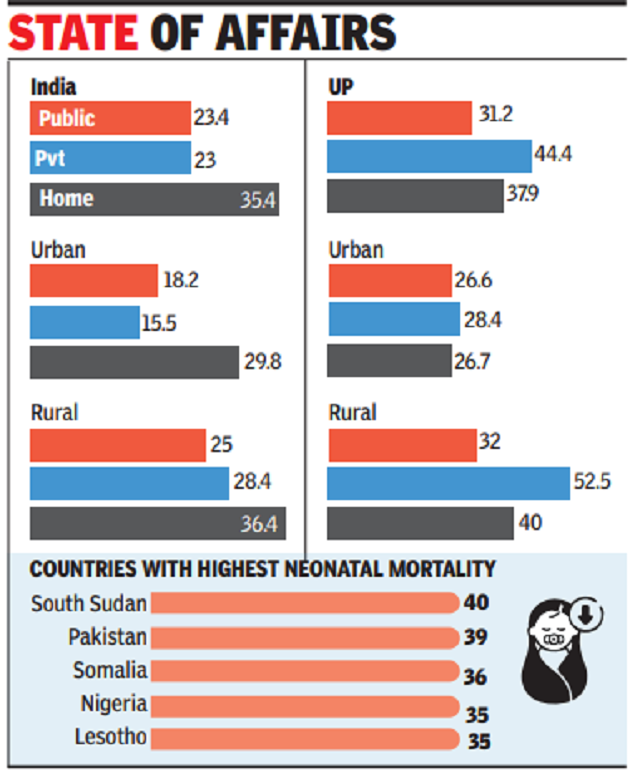Babies born in private hospitals in rural UP more likely to die in a month – ET HealthWorld

Babies of rural households in Uttar Pradesh are more likely to die within the first month if they are born in private health facilities than if they are born in public facilities or even at home. The neonatal mortality among rural UP residents in private facilities was 53 deaths per 1,000 live births in 2019, which was higher than that of any country in the world that year.
Private facility births for the state’s rural residents meant 63% more likelihood of death within the first month than public facility births and 29% greater than home births, according to a paper by researchers from research institute for compassionate economics (rice) and Brown University. The private sector in UP accounts for one in five births or approximately 9.7 lakh births. If all of the private facility births to rural mothers in UP had the same neonatal mortality rate as public facility births, about 20,000 deaths could be averted annually, pointed out the paper.
The paper, published in the Economic and Political Weekly, said the state contributed a disproportionate share of India’s maternal and new-born deaths: 27% of India’s neonatal deaths and over 35% of maternal deaths, compared to only 18% of births. Thus, improving maternal and neonatal mortality in UP would be critical to India improving its maternal and reproductive health indicators.
“It is surprising that neonatal mortality is higher among private facility births because mothers who give birth in private facilities have an advantage on other characteristics, such as nutrition and socio-economic status. For example, rural mothers who delivered in private facilities in the year before the NFHS 2019 was collected had an average BMI of 22.5, compared to 21.4 among the same group of women who delivered in public facilities,” noted the paper.
Though public facilities have better qualified personnel, those supposed to provide emergency services including caesarean surgeries often do not. Moreover, when referred to a community health centre or district hospital, the distance from the patient’s place of residence and the difficulty of arranging transport makes patients and their families opt for a closer private facility. “Our experience suggests that a further disincentive for visiting district hospitals is that district hospital staff tends to be even more rude and abusive towards rural families than CHC staff,” stated the paper. While public facilities will not do a caesarean without arranging for blood, especially in the case of women with very low haemoglobin level, private facilities do so despite the higher risk to the patient.
The statistics underline the need to further buttress UP’s public health system, so that fewer people are forced to depend on private healthcare. It also highlights the need to regulate private hospitals, especially those located in rural areas, which should help in ensuring that their standards improve tooTimes View
The private sector also manages to get patients from the public facility by paying commissions to ASHAs, ambulance drivers and others. The ASHA incentive for motivating a patient for delivery in public hospitals, Rs 600, has not been revised since 2005. Adjusting for inflation and economic growth, the authors estimated that the commission ought to be about Rs 3,600 per public facility birth. The Janani Suraksha Yojana incentive to families for birth in a public facility, which was set at Rs 1,400 in 2005, has not been revised either. The study also found that many of the private providers were untrained, whether doctors or ‘nurses’, but since the so-called doctors were mostly upper caste men with a lot of local influence and since they bribed local officials, they got away with it. Inappropriate care in the form of unnecessary caesarean sections and giving of medicines to induce labour too early leading to premature births were just some of the egregious practices in the private sector documented by the study.
The private sector also charged much higher than the government for deliveries. For rural UP residents, the cost of birth in private facilities averaged Rs 19,600 compared to Rs 1,100 for public facilities, partly due to the higher proportion of C-section deliveries. Interestingly, urban residents’ babies are more likely to survive if delivered in a private facility. The authors suggest two reasons for this: first, the socio-economic and maternal nutrition gaps between urban residents who deliver in public and private facilities are even greater than they are for rural residents; and second, a greater fraction of the private providers who serve urban residents have formal training.
For all the latest Health News Click Here
For the latest news and updates, follow us on Google News.

